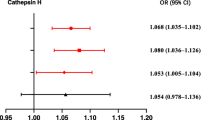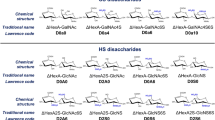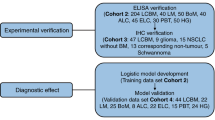Abstract
In this study we examined both the pH dependence of cathepsin B (cath B) activity and its stability at physiological pH of 7.5 in lung tumours and normal lung tissue by means of fluorogenic assays with Z-Arg-Arg-AMC as specific substrate. Specificity was verified with the cath B blocking inhibitors E-64 and CA-074. With respect to pH dependence of activity, we found a deviation from a normal-shaped pH- activity curve. Besides the typical activity peak at pH 6.0, there were shoulders at pH 4.5-5.5 and at pH 7.0-7.5. This heterogeneity was found in both tumour and normal tissue. To test the stability of cath B at physiological pH of 7.5, homogenates were kept at pH 7.5 for 60 min. Altogether, 82-100% of residual cath B activity was found at pH 5.0-5.5, whereas activity in the range between 5.5 and 7.4 dropped drastically to 26-42%. At pH 7.5, there was still 20-34% residual cath B activity detectable. To test the hypothesis whether the cath B fraction active at pH 7.5 is more abundant in tumour tissues compared with the normal counterparts, we determined this fraction in 91 pairs of lung tumour and normal lung tissue. We found a 2.3-fold increase of median cath B fraction active at pH 7.5 in tumour tissue, although this fraction represented only a small part (about 16%) of the native, acidic (pH 6.0) cath B activity. However, in contrast to native cath B at 6.0, the cath B fraction active at pH 7.5 was related to post-operative probability of survival in curatively operated patients, since activity values higher than 292 (muEU mg(-1) protein) were significantly associated with poor prognosis in patients with squamous cell carcinomas (n = 33, P= 0.04). It is concluded that in lung tumour and in normal lung tissue, cath B activity can be divided into at least three fractions with stability optima at different pH values, indicating various forms of cath B. The cath B fraction active at pH 7.5 provides prognostic information in patients with squamous cell carcinoma.
This is a preview of subscription content, access via your institution
Access options
Subscribe to this journal
Receive 24 print issues and online access
$259.00 per year
only $10.79 per issue
Buy this article
- Purchase on Springer Link
- Instant access to full article PDF
Prices may be subject to local taxes which are calculated during checkout
Similar content being viewed by others
Author information
Authors and Affiliations
Rights and permissions
About this article
Cite this article
Werle, B., Jülke, B., Lah, T. et al. Cathepsin B fraction active at physiological pH of 7.5 is of prognostic significance in squamous cell carcinoma of human lung. Br J Cancer 75, 1137–1143 (1997). https://doi.org/10.1038/bjc.1997.196
Issue Date:
DOI: https://doi.org/10.1038/bjc.1997.196
This article is cited by
-
Pepsin is a positive regulator of Ac-cathB-2 involved in the rat gut penetration of Angiostrongylus cantonensis
Parasites & Vectors (2016)
-
Cathepsin-B-mediated cleavage of Disabled-2 regulates TGF-β-induced autophagy
Nature Cell Biology (2016)
-
Mechanisms of Dendritic Cell Lysosomal Killing of Cryptococcus
Scientific Reports (2012)
-
Immunochemical analysis of cathepsin B in lung tumours: an independent prognostic factor for squamous cell carcinoma patients
British Journal of Cancer (1999)



